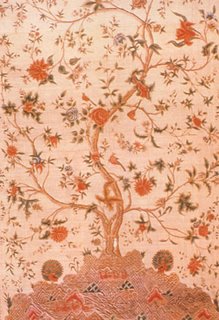
Since the RMIT Spiritual Centre is inter-faith and non-denominational in nature, any art work has to reflect this. The design rationale for the tapestry was set out by Cresside as follows:-
"In the midst....was there the Tree of Life....and the leaves of the tree were for the healing of the nations"
Revelations 22:2
The tree is a symbol resonant in all religions, visually meaningful in the ancient Mediterranean civilizations and in the Buddhist, Moslem, Christian and Jewish cultures. Originally the way it was envisioned and described in sacred Jewish texts led to its development as a motif in other early religious art, and its depiction dates to the first century.
It was used to represent life, death and resurrection because of its organic qualities and the notion of a living cosmos in a state of perpetual regeneration. The verticality of the tree also stood for a relationship established between heaven and earth as it moved through the three levels of the cosmos - the underworld through its roots, the earth and atmosphere through the trunk and lower branches, and the heavens as its upper braanches reached towards the light.
The tree encompasses the four seasons in its development, reminiscient of the life cycle of man. It reflects physical growth and spiritual awareness, tenacity and maternal qualities in its capacity to sustain lie through giving nourishment, and protection by providing shade and shelter.
It also brings the elements - earth, water, air and fire that constitute the material universe - together in its manifestation. Water circulates in its sap, earth sustains its structure through holding its root system, air feeds its leaves and its branches can be used to create fire.
The symbol of the tree of life is universal, not just in its religious context but through its depiction in textile art throughout the centuries. Through Hebrew and Hindu mythology it proliferated through all the embroidered and woven forms throughout the East. Mediaeval French and Flemish tapestries developed "verdure" and "millefleur" pieces that later informed seventeenth century English hangings. American patchwork adapted the tree from oriental rugs aand it took the form of willow and pine.
This design, comprising a strong but slender tree set against the sustaining colours and textures of the elements seeks to encompass and represent the rich historical symbolism of the Tree of Life. To its skeleton hundreds of individual leaves will be added representing people of all faiths and all nationalities across RMIT. The tapestry will speak to the many layers of meaning, both religious and secular, of the Tree of Life and its making will unite the designers and weavers in the spirit of community."
Cresside Collette March 2006
(the picture above is from an Indian palampore , or bed covering, in the collection of the Powerhouse Museum, Sydney)

0 Comments:
Post a Comment
<< Home